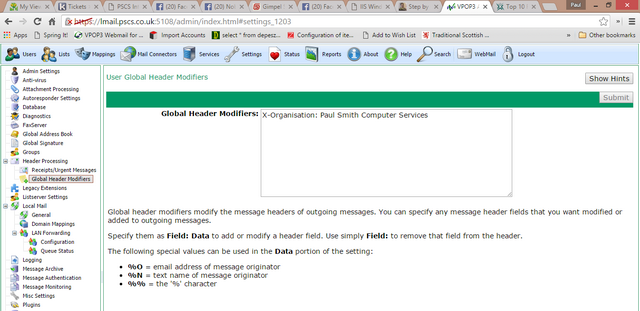
To get to this page, go to Settings → Header Processing → Global Header Modifiers
Global header modifiers are applied to all outgoing messages. These aren't needed, but there may be cases where you want to add them. The most common one would be an Organization/Organisation/X-Organisation header as in the example above.
You should be careful about adding 'random' header fields as they may mean something to other software and cause interoperability problems.
If you are going to use this facility, you should probably read and understand at least sections 1 to 3.2 of RFC 5322 to understand how message headers are formatted.
RFC 2076 is a useful list of common message headers. It is a bit old, but still useful. Note that header fields beginning with 'X-' are custom headers and should not have any important meaning.
To specify a header modifier, type it into the Global Header Modifiers box as it will appear in the final message header. You should put the header field name, followed by a ':' followed by the header field data, as described in RFC 5322.
If you have a header modifier, and that header field already exists in the sent message, then VPOP3 will modify the existing header field. If the header modifier has no data section, then the existing header field will be deleted (this may be useful for redacting data added by email clients, but be aware of possible interoperability issues). If you have a header modifier and the header field does not exist in the sent message, then VPOP3 will add that header field.
You can use %O in the field data to insert the email address of the message sender, or %N to insert the text name. Use %% to insert a single percent character.

